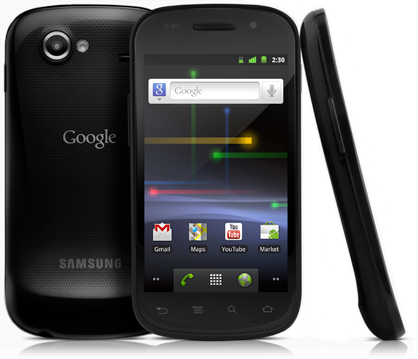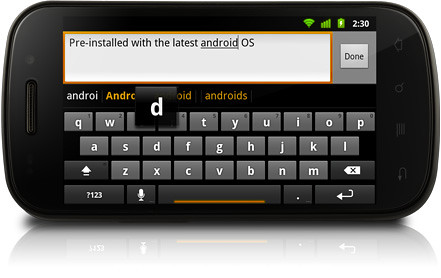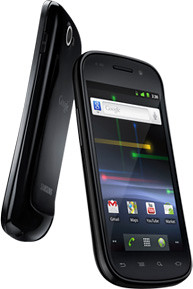
Google Nexus S is a promising Android device with a nice set of features such as the noise cancellation software, a 5MP camera, Wifi capability, and more than decent battery life. Being Google-branded means that it is leverages mostly on Google applications, and will therefore be much appreciated by Google fanboys and fangirls.
Nexus is a brand by Google. Their first attempt for a Google phone was called the Nexus One, in cooperation with HTC. The phone was moderately successful, but Google decided to partner with Samsung for the second generation Nexus, the Nexus S. The success of the Galaxy S series could have made Samsung the partner of choice for this iteration.
When we say a Google phone, it means that the phone was designed hands on by the Google Android team. What does this mean? We get the most out of Google & Android! Yay! I was so happy with how fast setup took. Would you believe it only took me a minute? I just entered my Google account credentials and the phone is ready to go. Nexus S is definitely designed for a Google user with built-in applications like Google Mail, Google Calendar, Google Contacts and a lot more.
Aesthetically, Google’s Nexus S is different from Samsung’s Galaxy S series but they do look alike. It follows Samsung’s shiny, black plastic casing. A big change from Nexus One’s metal finish. I like the way Nexus S looks even if some might think otherwise. A lot of consumers think that the black plastic finish doesn’t do the phone justice and makes it look gauche, but I disagree. It makes the phone lighter and it complements the big screen of the phone. At 4.55 ounces and with dimensions of 63mmx123.9mmx10.88mm or no bigger than a ladies’ wallet, you’re sure that you have a portable phone!
I was definitely awed with the big screen and found myself enjoying the browsing experience on this device. The speed of the device ought to be mentioned too and this most probably be because of the 1 GHz Hummingbird processor that Nexus S has.
Specifications

- Quad-band GSM: 850, 900, 1800, 1900
- Tri-band HSPA: 900, 2100, 1700
- HSPA type: HSDPA (7.2Mbps) HSUPA (5.76 Mbps)
- Wi-Fi 802.11 n/b/g
- Bluetooth 2.1+EDR
- Near Field Communication (NFC)
- Assisted GPS (A-GPS)
- microUSB 2.0
- 1GHz Cortex A8 (Hummingbird) processor
- 16GB iNAND flash memory
- 4.0″ WVGA (480×800)
- Contour Display with curved glass screen
- Super AMOLED
- 235 ppi
- Capacitive touch sensor
- Anti-fingerprint display coating
Connectivity
Nexus S’ greatest asset is that it is unlocked. This gives the consumer freedom to use any SIM card. Plus, it’s very convenient especially if you travel a lot. You don’t have to worry and can use any carrier’s SIM card for use.
Another awesome feature is Near Field Communication or NFC. Basically, NFC allows to use the phone in place of a credit card by simply tapping the phone against special sensors in retail stores. This is similar to the G-Pass at MRT stations. It also allows phones to swap data between each other via 3 methods: read, write, and exchange. Though it won’t have much impact now, it’ll surely be something great in the future. I’m sure they are still working on the security aspect of NFC but including it is a nice preview into the future! Can’t wait for this! Once Google gets some support from developers and from business, it’ll surely be a hit!
Nexus S has WiFi, bluetooth and GPS. I was disappointed with WiFi though. I tested this one time with Nexus S & another WiFi enabled smartphone side by side using the same WiFi network. Nexus S only has 1 bar of signal which is very poor while the other smartphone has 3 bars of signal. This is a deal breaker for me as I’m a huge user of WiFi.
Display
I love how big the display is. With the 4-inch super AMOLED 480×800 resolution screen, I felt that I don’t need a bigger device for my view preferences.
The contour display is nice too! The curved glass screen was definitely a welcome change in the Nexus phone! I heard though that the screen is flat but the glass is curved. No matter which is flat and which is curved, the design worked and I loved it!
Hardware
Nexus S has a three-axis gyroscope, accelerometer, digital compass, proximity sensor and light sensor. The light sensor works really well. It adjusts pretty well under poor light conditions or even extremely bright environment.
When it comes to hardware, the Nexus S is packs a punch with the 1 GHz hummingbird processor. This definitely is the major reason why the device has great speed performance, being able to handle multiple running apps and background processes.
However, I am concerned about phone memory. It only has 16GB internal memory. While some may think it’s enough but for heavy smartphone user like me, it definitely is not. It would be nice if they put an expansion slot for flexibility. I believe applications alone can quickly fill 16GB memory, how much more media such as music and videos? It’s also ironic that Google included moving Apps to an external storage in their OS, yet it removed the expansion slot in Nexus S. I wonder what Google was thinking.
Camera
I’m torn with the camera. It’s nice that Nexus S has a 5 megapixel back-facing camera but it just feels weird that even though it has a VGA front facing camera. However, Google doesn’t have a native application for video calling. That’s really why the front-facing camera was implemented right? Yes, we can use it for self-portrait but being able to do video chat is a big driver for implementing front-facing camera.
Another disappointment I have with Nexus S camera is that it doesn’t have digital zoom. The flash as well doesn’t have an auto-mode, it’s either on or off. It’s nice that it has a macro mode though. Generally, I believe Google & Samsung can improve a lot with Nexus S camera.
Everyone is so hung up on HD video recording. Too bad Nexus S doesn’t have that feature either. It only has 720×480 resolution video. It should be fine but it doesn’t stop there. All videos are recorded as .3gp format.
Battery
I’ve been using Nexus S heavily for a week. I had to charge it every night but it didn’t come to a point when I lost battery while I was out. Hence, I can say that Nexus S has a good battery life.
Official specifications has this to say about the battery life:
Talk time up to 6.7 hours on 3G (14 hours on 2G)
Standby time up to 17.8 days on 3G (29.7 days on 2G)
I also like the battery page in the Google device. You can see which application is using up most of the battery and some other information. This is especially useful if you’re still out and will need to conserve battery.
Software
Google Nexus S comes with the newest Android Operating System, version 2.3 called Gingerbread. The advantage of having a Google-branded phone is you get to experience it first! Other Android phones will have to wait for a couple of months but Nexus users will have to enjoy it way earlier.
One point worth mentioning is that there is no Android native application for screen capturing. As an iPhone user, I find it very useful to take screencaps of interesting stuff I stumble upon while browsing, and it is a snap to take a screen capture of whatever is on the screen. Unfortunately, this is hard to do with Android. One needs to have experience on software development kits before one can take a simple screenshot, which only takes two buttons on the iPhone. This could be inconsequential for some users, while a deal breaker for others.
3rd Party Software
There are 3rd party software that really stand out in my book. I love that they created it beautifully in Android OS.
The ones that I liked are Facebook, Foursquare, Angry Birds (it’s FREE!), Plurka, Nesoid Lite & of course, the Google apps.
The one that I dread, on the other hand, is Tweetdeck (geez, it really sucked!).
Summary

To summarize, here are the pros & cons through my 2 weeks of use:
PROS
- Google’s noise cancellation software when combined with audio hardware, it results in high quality calls. call recipient hear very little background noise.
- easy setup.
- google voice app pre-installed & deeply integrated into the Android OS.
- gingerbread operating system.
- drab gray to a black notification bar which helps save battery.
- on the fly creation of WiFi hotspots.d
- new keyboard.
- Google’s navigation and voice input applications.
- supports VoIP/SIP calling.
- clean install of Android, pure Google experience, no messy 3rd party software.
- unlocked – can use different SIM card when in another country
- screen is crisp & bright
- phone is very light & feels great in the hand
- good battery life
- mobile to cloud, bypasses PC. No need to sync Android phone with computer. All mails, calendars & contacts are all working through login with Gmail credentials.
CONS
- no HSPA+
- no external storage
- no HD recording
- poor wifi
- no dedicated camera button
- Market App is not user friendly
- No native video chat software
- Media experience is weak
- lack of notification light
- camera – no digital zoom function, flash mode has no auto setting
- camcorder saves in .3gp format, no HD video recording
Overall, I think Nexus S is a great Android device. If ever, there’ll come a time that I’ll need 2 phones then Nexus S will be my choice as backup. However, I’m sticking with my iPhone for now. Android has a long way to go but it definitely is promising!
——————–
This is the initial draft of my article. Final version can be found in Manila Bulletin’s May 16 issue. Also posted in MB’s website.



i wish you can also do a review on the new Samsung Galaxy S ll, the one with a dual core processor.